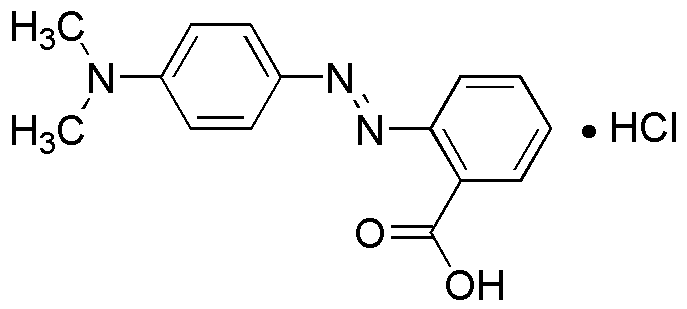Methyl red hydrochloride is widely utilized in research focused on:
- pH Indicator: Commonly used in titrations and laboratory experiments to indicate pH changes, providing a clear visual cue for researchers.
- Biological Research: Employed in microbiology for determining the metabolic activity of bacteria, helping researchers assess growth conditions.
- Textile Industry: Acts as a dye in the textile industry, offering vibrant colors and stability, which is essential for fabric production.
- Pharmaceuticals: Used in the formulation of certain medications, enhancing the stability and effectiveness of active ingredients.
- Environmental Testing: Applied in assessing water quality, particularly in determining the acidity of samples, which is crucial for environmental monitoring.
Información general
Propiedades
Seguridad y normativas
Aplicaciones
Methyl red hydrochloride is widely utilized in research focused on:
- pH Indicator: Commonly used in titrations and laboratory experiments to indicate pH changes, providing a clear visual cue for researchers.
- Biological Research: Employed in microbiology for determining the metabolic activity of bacteria, helping researchers assess growth conditions.
- Textile Industry: Acts as a dye in the textile industry, offering vibrant colors and stability, which is essential for fabric production.
- Pharmaceuticals: Used in the formulation of certain medications, enhancing the stability and effectiveness of active ingredients.
- Environmental Testing: Applied in assessing water quality, particularly in determining the acidity of samples, which is crucial for environmental monitoring.
Documentos
Hojas de datos de seguridad (HDS)
La SDS proporciona información de seguridad completa sobre la manipulación, el almacenamiento y la eliminación del producto.
Especificación del producto (PS)
La PS proporciona un desglose completo de las propiedades del producto, incluida la composición química, el estado físico, la pureza y los requisitos de almacenamiento. También detalla los rangos de calidad aceptables y las aplicaciones previstas del producto.
Certificados de análisis (COA)
Busque certificados de análisis (COA) ingresando el número de lote del producto. Los números de lote y de partida se pueden encontrar en la etiqueta de un producto después de las palabras "Lote" o "Lote".
Número de catálogo
Número de lote/lote
Certificados de origen (COO)
Este certificado de origen confirma el país en el que se fabricó el producto y también detalla los materiales y componentes utilizados en él y si se deriva de fuentes naturales, sintéticas u otras fuentes específicas. Este certificado puede ser necesario para cumplir con las normativas aduaneras, comerciales y regulatorias.
Número de catálogo
Número de lote/lote
Hojas de datos de seguridad (HDS)
La SDS proporciona información de seguridad completa sobre la manipulación, el almacenamiento y la eliminación del producto.
DownloadEspecificación del producto (PS)
La PS proporciona un desglose completo de las propiedades del producto, incluida la composición química, el estado físico, la pureza y los requisitos de almacenamiento. También detalla los rangos de calidad aceptables y las aplicaciones previstas del producto.
DownloadCertificados de análisis (COA)
Busque certificados de análisis (COA) ingresando el número de lote del producto. Los números de lote y de partida se pueden encontrar en la etiqueta de un producto después de las palabras "Lote" o "Lote".
Número de catálogo
Número de lote/lote
Certificados de origen (COO)
Este certificado de origen confirma el país en el que se fabricó el producto y también detalla los materiales y componentes utilizados en él y si se deriva de fuentes naturales, sintéticas u otras fuentes específicas. Este certificado puede ser necesario para cumplir con las normativas aduaneras, comerciales y regulatorias.


